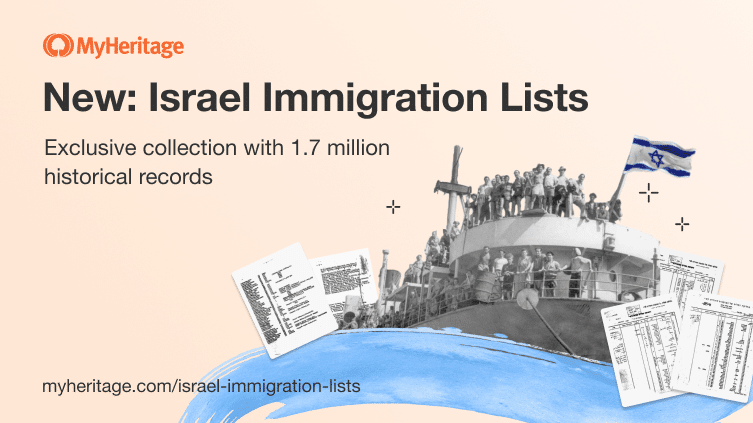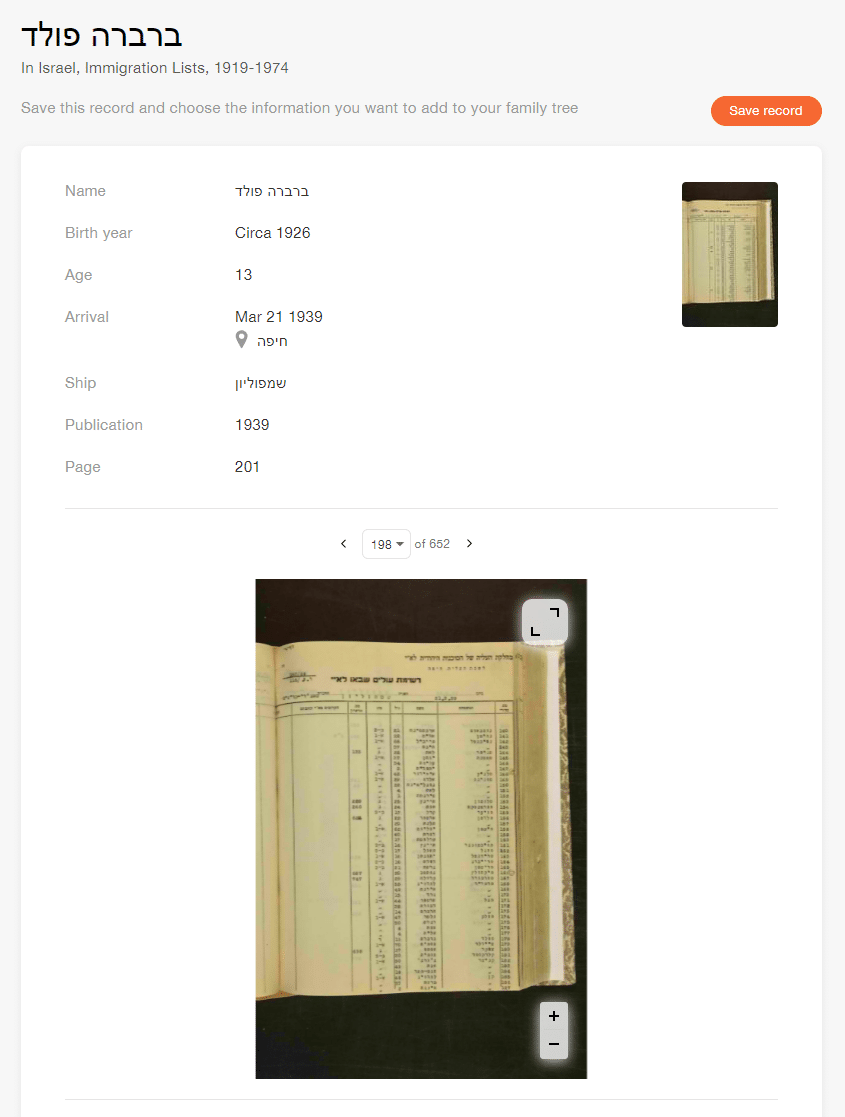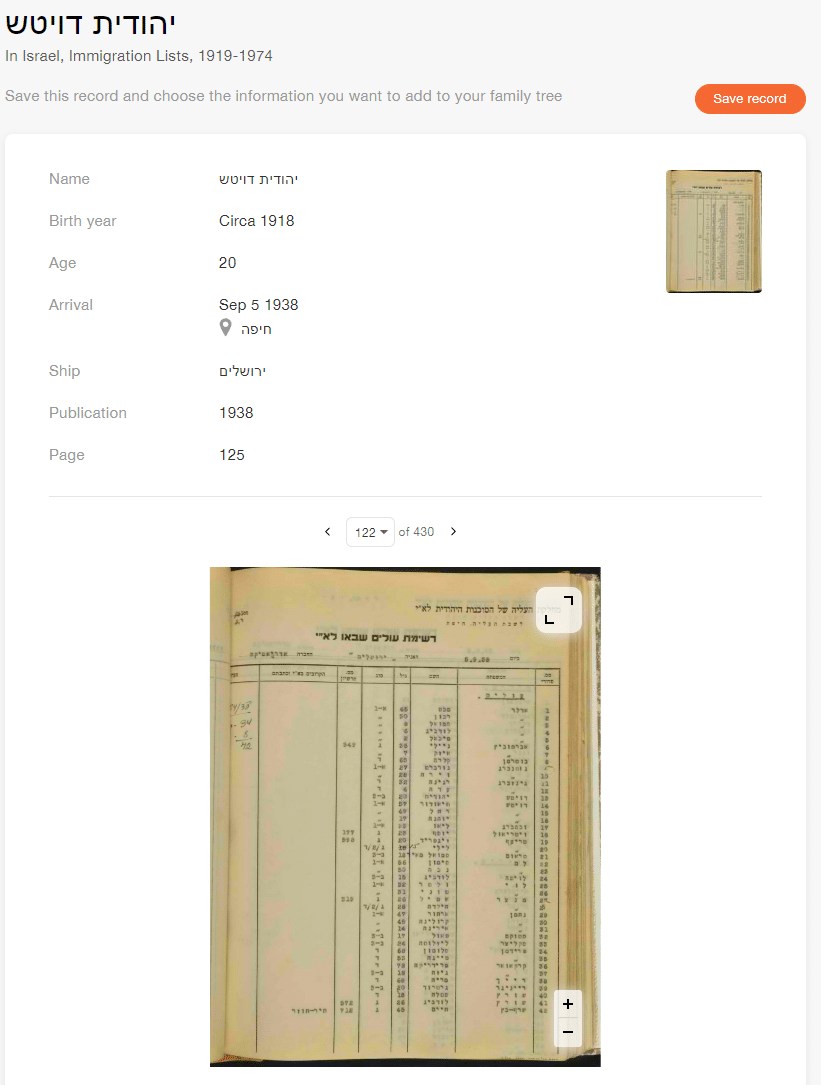MyHeritage Publishes Exclusive Huge Collection of Israel Immigration Records
- By Talya


We are delighted to announce sensationally good news: MyHeritage just published a huge new collection covering immigration to Israel from 1919 onwards, with 1.7 million records! And the best news is that we’ve made it completely FREE! This collection is the Israeli equivalent of the famous “Ellis Island” immigration database for the United States. This is probably the biggest news in Israeli genealogy in the last decade! For a period of more than a year, MyHeritage painstakingly indexed thousands of public domain images made available by the Israel State Archives that include all surviving records of all those who immigrated to Israel by ships and by planes from all over the world starting in 1919. MyHeritage is the first organization to create a searchable index for this valuable collection and associate it with the scanned images. The collection is available for all to search and view for FREE, without even having to sign up, making the information more accessible than ever before for anyone researching their Jewish roots in Israel. Almost every genealogist in Israel is expected to find direct ancestors and other relatives in this valuable collection and to know for the first time the precise circumstances of their arrival to Israel.
Search Israel, Immigration Lists for free
The records in this collection include the name of the immigrant and the names of relatives who immigrated with them, country of origin, the name of the ship they arrived on, the date of arrival, names of parents, names of relatives who are expecting them in Israel, and their destination city in Israel.
Following the end of World War I, the British occupied Palestine from 1919 until Israel declared its statehood in 1948. During that period, there were four waves of immigration, or aliyot in Hebrew. There were many reasons why people made aliyah: some were fleeing antisemitism, some leaving for political or religious reasons, many searching for new hope and a new life following the World Wars.
Historians have defined several waves of aliyah between 1882 and the beginning of World War II. This collection starts with the Third Aliyah period. The first two waves took place from 1882 to 1918 under Ottoman rule, and are not covered in this collection.
The Third Aliyah took place between 1919 and 1923 and was primarily composed of Eastern European Jewish immigrants called halutzim, or pioneers, who left Europe after World War I to create a new future for themselves.
The immigrants who arrived during the Fourth Aliyah, from 1924 to 1929, were mostly Jewish people who arrived as a result of the rise in antisemitism throughout Europe and the Middle East. Most came from Eastern European countries like Poland, the Soviet Union, Romania and Lithuania but there were also Jews from Yemen and Iraq.
The Fifth Aliyah, from 1929 through 1939, saw the influx of 250,000 immigrants, the largest wave yet. Most were fleeing Poland, Germany, Austria, Czechoslovakia, and Greece in response to growing antisemitism and the rise of Nazism. There were also Jewish immigrants from Turkey, Iran, and Yemen.
From 1933 to 1948, the British enforced immigration quotas, limiting the number of Jews who could move to Palestine. Many Jews found ways to enter Palestine illegally. The collection does not include lists of illegal immigrants, but there are several lists of children who arrived as part of the youth immigration during this time period.
The collection was created from scanned books stored by the Israel State Archives with lists of immigrants (most of them in Hebrew), arranged in chronological order according to the arrival dates of the ships or planes to Palestine or the State of Israel. These registers were previously used by the Jewish Agency’s Relatives Search section. The records also include the arrival of tourists to Israel, or the return of Israeli residents from a trip abroad. Pedestrian arrivals are also listed, i.e. those who came in through border crossings in the north or south.
Flexible searching
Although most of the data in this collection is in Hebrew, MyHeritage’s powerful Global Name Translation Technology™ allows you to search the collection in English and other languages! The names in the records found will be transliterated back to your language for your convenience.
This collection further expands MyHeritage’s extensive resources for Jewish genealogy. MyHeritage is home to the world’s largest collection of Jewish family trees and is the only major commercial genealogy company to support Hebrew.
Examples
The collection contains a record of Bracha Fuld, a Jewish resistance fighter who died at the age of 18 in an attempt to help Jewish Holocaust refugees enter Palestine. She was the first female Jewish soldier killed during the pre-state conflict with the British and a street is named after her in Tel Aviv.
Thanks to MyHeritage’s Global Name Translation Technology™, a search for her original name of Barbara Fuld in English brings up the correct record in Hebrew along with a transliteration of the Hebrew name into English.
Bracha was just 13 years old when she arrived in Palestine from Germany. The record includes the date and place of her arrival: March 21, 1939 in Haifa. It also includes the name of the ship: SS Champollion.
Also found in this collection is the record of Judith Deutsch-Haspel, a renowned Austrian swimmer, who was named “Outstanding Austrian Female Athlete of 1935” by the Austrian Sports Authority after beating the record in middle and long distance swimming in 1935. Though chosen to represent Germany in the 1936 Olympic Games, she refused, stating: “I refuse to enter a contest in a land which so shamefully persecutes my people.” Soon after, Judith emigrated to Palestine, where she became the Israel national champion. The record includes her age at the time of her immigration, 20; her arrival date, September 5, 1938; the place of her arrival, Haifa; and the ship she arrived on, the Jerusalem.
The image includes additional details. Judith immigrated with her father, Theodore, who was 57 years old; her mother, Rachel, who was 49 years old; and her sister, Johana, who was 17 years old.
Summary
We are delighted to publish this valuable collection of Israel immigration spanning nearly 60 years of immigration to Palestine and Israel. Anyone searching for information about their Jewish roots is likely to find a family treasure in this collection. We’ve made this collection completely free as a gift to the community.
Search Israel, Immigration Lists for free
If you have a family tree on MyHeritage, our Record Matching technology will notify you automatically if records from this collection matches your relatives. You’ll then be able to review the record and decide if you’d like to add the new information to your family tree. Record Matches with this collection are free too.
Enjoy!













